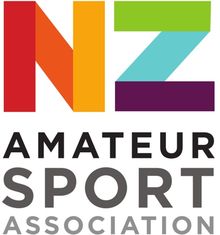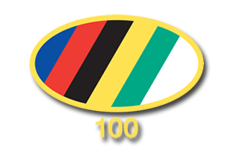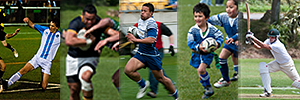Wellington's Ghost Rugby clubs - Part 4 Selwyn Football Club, Thorndon
Above: The 1919 Wellington representative team, featuring three Selwyn players, the Shearer brothers and de Clifton
WELLINGTON’S “GHOST” RUGBY CLUBS
Part 4 – “The All Black Plumbers” – Selwyn Football Club, Thorndon
Today, 7 Cottleville Terrace is a well-restored Victorian villa on one of Wellington’s historic Thorndon streets. Over 100 years ago, it was the home of Alexander and Mercy Shearer, whose two sons, Sidney (Sid) and Jack were to become the only All Blacks ever selected from the now long-forgotten Selwyn Football Club, which had a proud 50-year history as an important member of the Wellington Rugby Football Union.
The Selwyn Football Club was originally formed in 1888, with its first recorded “scratch” match against the “Our Boys Club” (later to become Poneke), in Thorndon reported as taking place on 30 March the following year. The club was based on May Street (the street now next to New World, in Thorndon), with its early matches played on the Railway Reserve reclamation. at Pipitea.
The earliest recorded Selwyn team (from April 1889) comprised: McDowell, Beale, Curtis (2), Allen, Sealy, Seaward, Oswin, Skinner, Evans, Johnson, Samuels, Marchant, Chatwin, McKerrow and Rose. David Skinner was later to become President of the Polhill Club, (featured in last week’s story), while the other members of the team were former pupils of the The Terrace and Thorndon schools, both of which had already established a strong relationship with the Poneke club before the Selwyn club was formed.
Known as “the Selwyns” (and most likely named after the successful Auckland-based Selwyn Football Club which had won the Junior Cup in Auckland the prior year), the club applied to affiliate to the Wellington Rugby Football Union in 1890, with the intention to enter a team into the Third-Class Championship. Prior to this time, the 10-shilling Union affiliation fee was considered too large a financial hurdle to joining.
However, in an unusual decision, at a General Meeting of the Union in March 1890, the application was “declined by a large majority”. The reason provided was that there were not enough grounds for another Club to be able to train. This was the first (and last) time in the history of the Wellington Rugby Union that an application for membership was not granted. In fact, it was reported (at the time) that it was something that had never happened before in New Zealand, with the press noting that “the action of the local Union [is] having a detrimental effect upon the game in this district.”

Following the decision, the club considered disbanding, with its members to join the neighbouring Rivals Club. However, the club’s members decided to appeal the decision under Rule 6 "that any Club in the Provincial District of Wellington willing to conform to the rules of the Union be eligible for membership”.
On 27 May 1890, the application of the Selwyn Club for admission to the Rugby Union was re-considered. Thomas Wilford, Captain of the Epuni Club, moved that the Selwyn Club should be admitted as a Junior Club. He pointed out that arrangements had now been made for additional practice grounds, and such being the case he did not see why “the Selwyns” should be debarred from membership. The resolution was seconded and after some discussion, it was carried by 12 votes to 2.
With its future assured, the club then leased the Hobson Street paddock for the considerable sum of 20 pounds per annum, an amount which “proved somewhat of a strain on its resources”. The first fifteen of the club played 14 matches during the 1890 season, winning 8, losing 5, and drawing 1.
In 1894 fresh controversy emerged for Selwyn, as two Wellington representatives Fred Galloway (Athletic) and McLaren (Melrose), both graded as senior players, joined the Club. As a result, the Union declared Selwyn to be a Senior club, (as senior players were not eligible to play for Junior clubs).
There was widespread condemnation of the move by the Union, with many noting “there is not a footballer in Wellington who thinks the Selwyns have the ghost of a chance for the Senior Championship - if they won a solitary match they would be lucky.” The Union quickly rescinded its decision with the two players not playing for the club during the season. Selwyn retained its Junior club status until 1915, when (after winning the Junior Championship for the first time, a feat it repeated in 1917), the club joined the Senior Championship.
In World War One, 110 members of the club served in the New Zealand forces, with 15 losing their lives, namely: Cedric Leeks, Osric Leeks, Ivan Leeks, A. Harris, J. McKegan, John Given, J. Faulknor, P. Sheeran, H. Feild, Alexander McRae, C. Haughey, Frank Desmond, A. Callum, Harold Easton and Leonard Larkin. The deaths of the three Leeks brothers in 1915 was a particularly cruel blow. The boys were educated at the Te Ore Ore near Masterton, and later at Clyde Quay School in Wellington, before joining the Selwyn club in 1908.
The Shearer brothers (Sid and Jack) were members of the Selwyn club for many years, following their early education at The Terrace School. Their older brother, Alexander (known as Alick), was also Vice-President and Club Captain of “the Selwyns”. In 1911, Sid was infamously suspended for 12 playing Saturdays for striking another player. All three boys were excellent swimmers and achieved success in the pool at the Thorndon club.
Before the War, Jack Shearer had enrolled at the Wellington Technical College in 1914, qualifying as a Plumber, before being called up in the 33rd Reinforcements in 1917. Jack’s older brother Sid had also qualified as a Plumber and both men were employed by “Futter and Jenson, City Plumbing Works”. Both Jack and Sid were conscripted in 1917 and served overseas in Europe, Jack as a Cook and Sid as a Sapper, with both boys discharged from active service in August 1919. Following the end of the War, in 1919 the Selwyn Club registered 30 new players, including the returned Shearer brothers, and the following year the club had teams in every grade of Wellington Rugby.
In July 1920, the press reported that “the eleventh-hour, inclusion of J. Shearer, the Selwyn forward, in the New Zealand team for Australia has caused a lot of pleasure to his many friends”. Jack played five matches as a Loose Forward for the All Blacks that year. Four matches in Australia and one against Wellington.
(The New Zealand Rugby official archive of All Blacks maintained by the New Zealand Rugby Museum incorrectly notes that Jack was selected from the Poneke Club, an error requiring correction.)
In 1921, both boys transferred to the Poneke club, with Sid being selected for the All Blacks that year and the following year. Sadly, their father Alexander never saw them achieve national honours, having died in 1908, when Sid was 18 and Jack, 14.
The period following World War One was when Selwyn achieved its greatest success in Wellington’s Senior Grade. In 1919, the club made the semi-finals of the Senior Championship, losing to Poneke (the eventual Champions). In fact, in 1923 the club fielded a team in every Wellington grade following the recruitment of 20 new members, with an off-season Athletic club also formed to maintain the players’ fitness. However, in 1925, the senior side lost every game in the season and was relegated from the A to the B division, which was to eventually lead to a merger in 1932 with Melrose.
Overall, the Selwyn club provided 19 Wellington representatives over its history: David Bruce (1918-19), Harry Chadwick (1923), Albert de Clifton (1914, 1919, 1920-21), L Earl (1920), James Flack (1915), W H Kent (1919), W Lomas (1914), Gordon McKay (1919), 1921 N McPhee (1914-1915), V J Mulheron (1926), Gavin Peacock (1922), W Reeve (1920, 1922-1924), Malcolm Rose (1920, 1923), Jack Shearer (1919-20), Sid Shearer (1919-20), C S Smith (1920), S W Ward (1931), Samuel Wogan (1920, 1922, 1924), and R Young (1925-26).
Of specific note, Albert (Bert) de Clifton went on to become a representative referee in the 1930s and a member of the executive of the New Zealand Referees Association.
As noted, Selwyn decided to amalgamate with the Melrose in March 1932, to form the Melrose-Selwyn Rugby Club, “a cumbersome title, which the official attending to the Athletic Park score-board shortened (appropriately, no doubt most people thought), to "Melwyn."
The culture of the merged club deteriorated over the next three seasons. An acrimonious meeting at the club, in which allegations of financial impropriety were made, was held in early 1936 with a motion to disband. However, on 11 March 1936, the merged Club renamed itself the “United Rugby Football Club”, playing in a maroon jersey with white collar, in the Senior Second Division. However, the damage had been done and the united club folded a year later, in 1937.
Steven White, 19 Mar 2019
Adam Julian, 19 Mar 2019
Steven White, 12 Mar 2019
Adam Julian, 04 Mar 2019
Steven White, 12 Feb 2019








.jpg)






